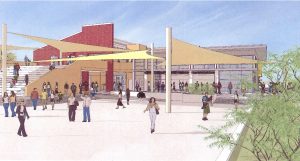
Every chair at every table is filled. A long line forms for seats at a computer. Whether they are frantically cramming for an AP Biology quiz or trying to make some time for pleasure reading, many students are spending their free time in the school library.
Meanwhile the librarians are trying to make sure the library doesnít exceed its maximum capacity of 210 people, which represents about eight percent of the student body.
Although librarian Susan Marks has only been the librarian since the beginning of the academic year, she is always surprised at how busy the library is during its recently extended hours. But contrary to popular belief, she feels that it is not that the school has too little resources, rather, it is what MVHS has too many of — students — that is causing the issue of a lack of workspace.
“They have amazing resources. I came from a school that struggled … but in general this school is very well equipped, staffed, etc.,” Marks said. “But MVHS is the biggest [school] in the district, definitely, and I believe I’ve heard that it’s the smallest area-wise.”
Not only is the physical space small compared to the student body — so is the librarian to student ratio. The state passed California Model School Library Standards in September 2010, which call for one full-time credentialed teacher librarian per every 785 students. As of now, the only person to fit such criteria is Marks herself. But according to Marks, as the state is not currently supplying enough money for schools, California schools refer to the standards as recommendations as opposed to mandatory measures. After all, their expectations for 28 books per student — 72,800 books in total — are hardly realistic for 17,775 books that the library has now.
Junior Kevin Lim, who tutors math after school, feels that the lack of books — textbooks, in particular — is the prime handicap of the library.
“I think the library itself is fine as it is. The new hours are great, but I just wish they had more copies of textbooks there,” Lim said. “I kind of feel that it’s uncomfortable if I have to ask others for their book, and if they’re not done, I have to scavenge for books when thereís one right there that I just can’t use.”
Though the library is often full, students also have the option of using the Career Center as a work space. Students generally start coming to the Career Center more often after the start of their junior year for college representative visits and application workshops. According to Career Center liaison Miriam Taba, students come primarily to use the computers and printer when the library is full or closed. This results in various resources unique to the Career Center — SAT books, college catalogs, books to consult on future jobs — being overlooked.
“You can lead a horse to water, but you can’t make it drink,” Taba said. “We have stuff available but weíre not going to drag you here to use it.”
The big picture
According to Assistant Principal Brad Metheany, the FUHSD Board of Trustees has approved the tearing down of the cafeteria building in order to build a new one with a bigger kitchen to accommodate the large student body. Classrooms will also be built: two physics labs, a programming lab, and a research lab, which will create additional workspaces for students. The construction is tentatively planned to occur in January 2013.
“It sounds great,” Marks said. “[The new building will bring] wonderful resources for both classrooms and students, especially in this day and age of budget cuts.”
Lynbrook High School recently added new labs to its campus as well, including a Flex Lab where teachers can hold their classes. Meant to be as flexible and suited for interactive learning as possible, the Flex Lab has movable furniture, two interactive whiteboards called Smartboards, three projectors, retractable cords on the ceiling, laptops and a sound system.
“The old-school way of teaching is basically teacher-centered,” LHS librarian Kimmie Marks said. “This room allows a student to be a teacher.”
LHS administrators are planning on building a Global Learning Lab in the future, which will be an extended version of the Flex Lab. The Flex Lab is being used to test what works and what does not.
“You people are going to be leaders of the free world in the future,” Marks said, “and weíre just trying to push the envelope on what we can do with education to prepare you with those 21st century skills.”




